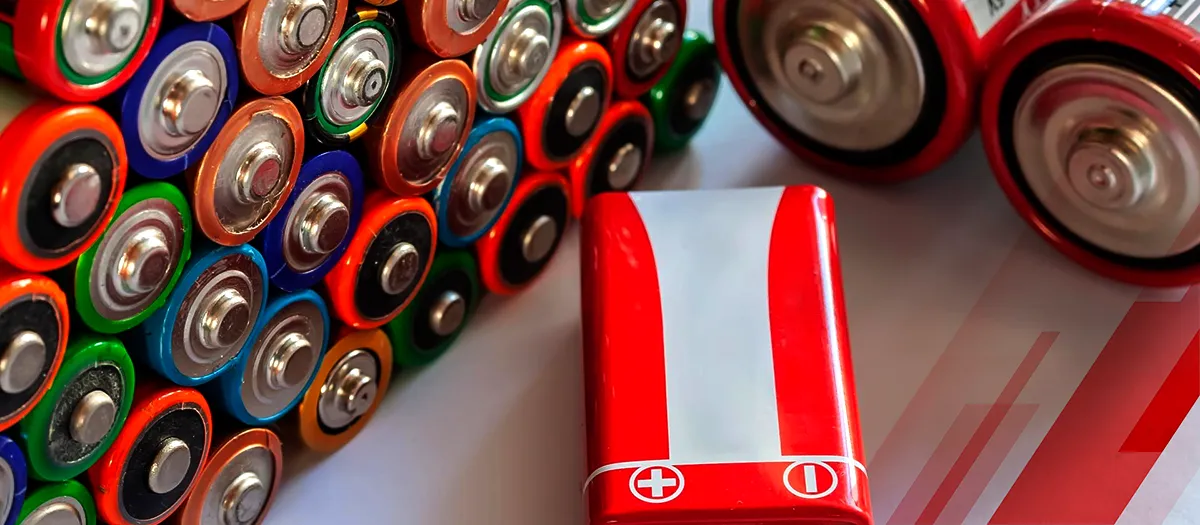Everyday use of phones and laptops relies on efficient battery performance. These essential devices are powered by batteries, which serve as crucial energy storage units. However, the manufacturing of these batteries involves the use of diverse battery materials, each playing a significant role in the functionality and performance of the devices.
So, let's dive in and understand the composition and significance of these materials that power our daily lives.
Understanding the Battery Materials
A battery transforms its chemical energy into electrical energy through reduction-oxidation reactions using its active materials, commonly known as electrodes. The battery is made with various components, such as anode, cathode, electrolyte, current collectors, battery separator, and battery electrolyte.
These materials in batteries play a vital role in battery construction. The battery contains one or many identical cells. Each cell stores electrical power as chemical energy in two electrodes separated by an electrolyte.
With the increasing need for batteries, there has been a significant rise in the demand for materials for batteries. As per Kings Research's recent analysis, the global battery materials market is likely to garner a value of $4.35 billion by 2030.
Exploring the Key Battery Materials and Their Functions
The battery contains various components, which are made with various materials. Below are the main materials used in battery manufacturing.
- Lithium
Lithium is a key component in lithium-ion batteries, serving as the primary material for the battery's anode. It is highly reactive and has a high electrochemical potential, making it ideal for energy storage in batteries.
- Graphite
Graphite is commonly used in the anode of lithium-ion batteries due to its ability to intercalate lithium ions, allowing for the storage and release of electrical energy.
- Cobalt
Cobalt is often used in the cathode of lithium-ion batteries, contributing to the battery's overall energy density and stability. It helps improve the performance and lifespan of the battery.
- Nickel
Nickel is another key material in the cathode of lithium-ion batteries, often used in combination with other metals like cobalt and manganese to enhance the battery's energy density and performance.
Key Types of Batteries and Their Materials
The manufacturing of various batteries depends on the specific application, with each type utilizing a range of materials. Below are common battery types and the key materials employed in their production.
-
Primary Batteries
Primary batteries are designed for single use and cannot be recharged. They typically use materials such as zinc-carbon and alkaline for the electrodes and electrolytes.
-
Secondary Batteries or Rechargeable Batteries
Secondary batteries, or rechargeable batteries, can be recharged and reused. They often use materials such as lithium, graphite, cobalt, nickel, and manganese in various combinations for the electrodes, electrolytes, and separators.
-
Lithium-Ion Batteries
Lithium-ion batteries are widely used in portable devices, electric vehicles, and energy storage systems. They commonly utilize materials such as lithium, graphite, cobalt, nickel, and manganese for the electrodes, electrolytes, and separators.
-
Lithium Polymer Batteries
Lithium-polymer batteries use a polymer electrolyte instead of a liquid electrolyte. They often contain materials such as lithium and polymers for the electrodes and electrolytes.
-
Lead-Acid Batteries
Lead-acid batteries are commonly used in automotive and uninterruptible power supply (UPS) applications. They use lead dioxide and sponge lead for the electrodes and a sulfuric acid solution as the electrolyte.
Are EV Battery Materials a Sustainable Approach?
To make more sustainable batteries for electric vehicles (EV), new extraction processes, battery chemistries, and materials are paving the way for a more sustainable future. EV battery materials are complex containing many rare earth elements (REE), such as lithium, nickel, cobalt, and graphite.
However, these materials are difficult to produce from a sustainability standpoint. Manufacturers are moving fast to fix the highly carbon-intensive process of producing electric vehicle batteries. For example, Electra Battery Materials produces secure, green, ethical battery raw materials, including cobalt sulfate and recycled battery materials, with a focus on a low-carbon footprint within the EV supply chain.
The effort to recycle battery materials, including lithium, cobalt, and nickel, is becoming increasingly important as more electric vehicles age out of the vehicle fleet. These materials can be recycled infinitely without losing their power, contributing to a more sustainable and circular battery supply chain.
These efforts and developments in extraction, recycling, and sustainability initiatives are contributing to making EV batteries more sustainable and environmentally friendly.
How is the Recycling of Battery Materials Driving Change?
The demand for batteries is on the rise across multiple industries, leading to an increased need for materials for batteries. However, the disposal of used batteries poses environmental and human health risks due to the waste they generate. Addressing this situation requires a proactive approach.
Recycling battery material is a sustainable method that offers numerous environmental, economic, and resource conservation benefits. It reduces waste, mitigates water and soil contamination, and prevents landfill disposal. Recycling also conserves non-renewable raw materials like lead, nickel, steel, zinc, mercury, cobalt, lithium, and silver, promoting their reuse in new batteries.
Both government organizations and numerous companies are actively participating in environmentally friendly initiatives to tackle this issue and promote sustainable battery management practices.
For example, RecycLiCo Battery Materials, to enable zero-loss battery production, recovers nearly 99% cathode metals from battery scrap, which it upcycles into high-purity, battery-ready materials. With the responsible use of these materials and recycling initiatives, we can take a step toward a greener and more sustainable future.
Quick Recap
The world of battery materials is complex and plays a vital role in modern technology. From the mining of raw materials such as cobalt, lithium, and nickel to the recycling of used batteries, every stage of the battery life cycle presents unique challenges and opportunities.
As we strive for more sustainable and environmentally friendly solutions, the responsible management of materials used for batteries becomes increasingly crucial. By prioritizing recycling, resource conservation, and innovation in material development, we can pave the way for a greener and more efficient future in the realm of energy storage and technology.




